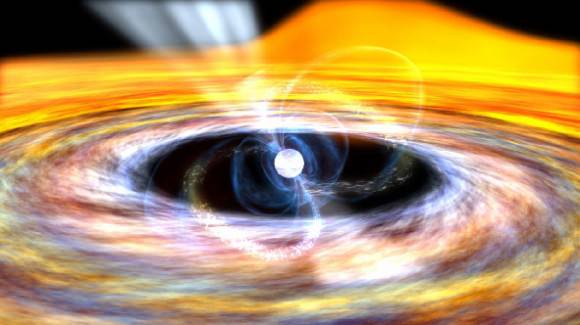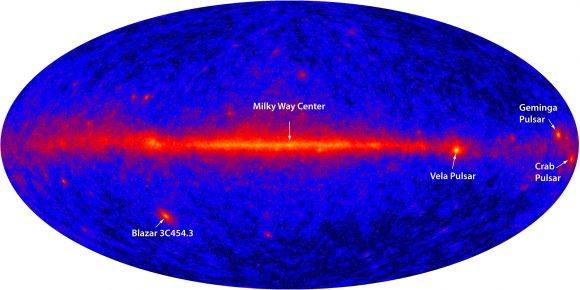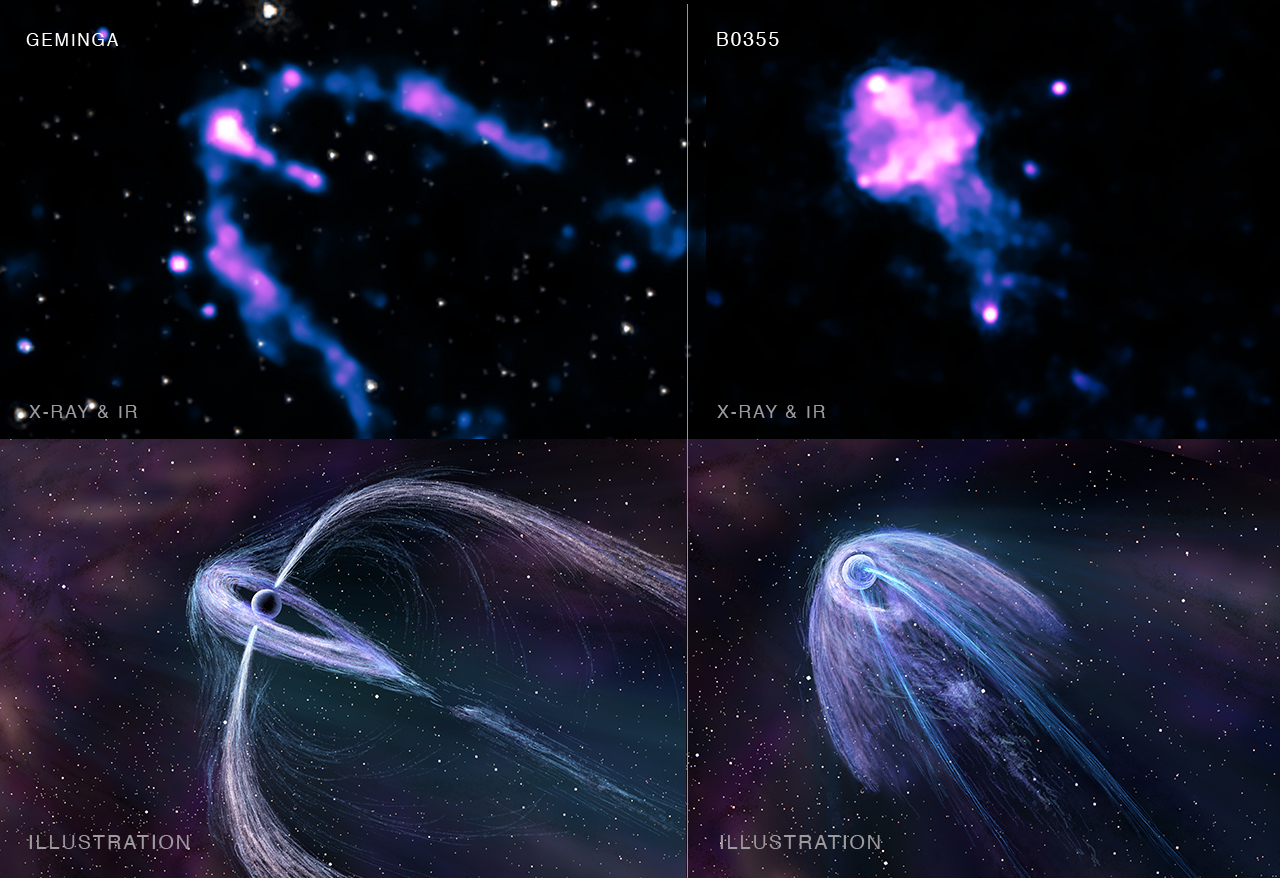Since they were first discovered in the late 1960s, pulsars have continued to fascinate astronomers. Even though thousands of these pulsing, spinning stars have been observed in the past five decades, there is much about them that continues to elude us. For instance, while some emit both radio and gamma ray pulses, others are restricted to either radio or gamma ray radiation.
However, thanks to a pair of studies from two international teams of astronomers, we may be getting closer to understanding why this is. Relying on data collected by the Chandra X-ray Observatory of two pulsars (Geminga and B0355+54), the teams was able to show how their emissions and the underlying structure of their nebulae (which resemble jellyfish) could be related.
These studies, “Deep Chandra Observations of the Pulsar Wind Nebula Created by PSR B0355+54” and “Geminga’s Puzzling Pulsar Wind Nebula” were published in The Astrophysical Journal. For both, the teams relied on x-ray data from the Chandra Observatory to examine the Geminga and B0355+54 pulsars and their associated pulsar wind nebulae (PWN).

Located 800 and 3400 light years from Earth (respectively), the Geminga and B0355+54 pulsars are quite similar. In addition to having similar rotational periods (5 times per second), they are also about the same age (~500 million years). However, Geminga emits only gamma-ray pulses while B0355+54 is one of the brightest known radio pulsars, but emits no observable gamma rays.
What’s more, their PWNs are structured quite differently. Based on composite images created using Chandra X-ray data and Spitzer infrared data, one resembles a jellyfish whose tendrils are relaxed while the other looks like a jellyfish that is closed and flexed. As Bettina Posselt – a senior research associate in the Department of Astronomy and Astrophysics at Penn State, and the lead author on the Geminga study – told Universe Today via email:
“The Chandra data resulted in two very different X-ray images of the pulsar wind nebulae around the pulsars Geminga and PSR B0355+54. While Geminga has a distinct three-tail structure, the image of PSR B0355+54 shows one broad tail with several substructures.”
In all likelihood, Geminga’s and B0355+54 tails are narrow jets emanating from the pulsar’s spin poles. These jets lie perpendicular to the donut-shaped disk (aka. a torus) that surrounds the pulsars equatorial regions. As Noel Klingler, a graduate student at the George Washington University and the author of the B0355+54 paper, told Universe Today via email:
“The interstellar medium (ISM) isn’t a perfect vacuum, so as both of these pulsars plow through space at hundreds of kilometers per second, the trace amount of gas in the ISM exerts pressure, thus pushing back/bending the pulsar wind nebulae behind the pulsars, as is shown in the images obtained by the Chandra X-ray Observatory.”
Their apparent structures appear to be due to their disposition relative to Earth. In Geminga’s case, the view of the torus is edge-on while the jets point out to the sides. In B0355+54’s case, the torus is seen face-on while the jets points both towards and away from Earth. From our vantage point, these jets look like they are on top of each other, which is what makes it look like it has a double tail. As Posselt describes it:
“Both structures can be explained with the same general model of pulsar wind nebulae. The reasons for the different images are (a) our viewing perspective, and (b) how fast and where to the pulsar is moving. In general, the observable structures of such pulsar wind nebulae can be described with an equatorial torus and polar jets. Torus and Jets can be affected (e.g., bent jets) by the “head wind” from the interstellar medium the pulsar is moving in. Depending on our viewing angle of the torus, jets and the movement of the pulsar, different pictures are detected by the Chandra X-ray observatory. Geminga is seen “from the side” (or edge-on with respect to the torus) with the jets roughly located in the plane of the sky while for B0355+54 we look almost directly to one of the poles.”
This orientation could also help explain why the two pulsars appear to emit different types of electromagnetic radiation. Basically, the magnetic poles – which are close to their spin poles – are where a pulsar’s radio emissions are believed to come from. Meanwhile, gamma rays are believed to be emitted along a pulsar’s spin equator, where the torus is located.
“The images reveal that we see Geminga from edge-on (i.e., looking at its equator) because we see X-rays from particles launched into the two jets (which are initially aligned with the radio beams), which are pointed into the sky, and not at Earth,” said Klingler. “This explains why we only see Gamma-ray pulses from Geminga. The images also indicate that we are looking at B0355+54 from a top-down perspective (i.e., above one of the poles, looking into the jets). So as the pulsar rotates, the center of the radio beam sweeps across Earth, and we detect the pulses; but the gamma-rays are launched straight out from the pulsar’s equator, so we don’t see them from B0355.”

“The geometrical constraints on each pulsar (where are the poles and the equator) from the pulsar wind nebulae help to explain findings regarding the radio and gamma-ray pulses of these two neutron stars,” said Posselt. “For example, Geminga appears radio-quiet (no strong radio pulses) because we don’t have a direct view to the poles and pulsed radio emission is thought to be generated in a region close to the poles. But Geminga shows strong gamma-ray pulsations, because these are not produced at the poles, but closer to the equatorial region.”
These observations were part of a larger campaign to study six pulsars that have been seen to emit gamma-rays. This campaign is being led by Roger Romani of Stanford University, with the collaboration of astronomers and researchers from GWU (Oleg Kargaltsev), Penn State University (George Pavlov), and Harvard University (Patrick Slane).
Not only are these studies shedding new light on the properties of pulsar wind nebulae, they also provide observational evidence to help astronomers create better theoretical models of pulsars. In addition, studies like these – which examine the geometry of pulsar magnetospheres – could allow astronomers to better estimate the total number of exploded stars in our galaxy.
By knowing the range of angles at which pulsars are detectable, they should be able to better estimate the amount that are not visible from Earth. Yet another way in which astronomers are working to find the celestial objects that could be lurking in humanity’s blind spots!
Further Reading: Chandra X-Ray Observatory


Can you people even hear yourselves?? Emit gamma and radio wave pulses, magnetosphere, x rays from particles launched in two jets and so on. Does it even cross your mind that these findings you describe are all electromagnetic phenomenon. To somehow attribute these massive electromagnetic forces to a gravitational source is beyond comprehension.
The energetic forces you are observing are 10 to the 39th times more powerful than gravitational forces you imagine created them. That approaches infinitely more powerful.
The universe is fundamentally an electromagnetic structure. Until you recognize and acknowledge this fact your interpretation of radio telescope data will continue to be infantile, relying on imbecilic comparisons to jellyfish.
Without a thorough knowledge of electrical engineering and plasma physics it is curious why anyone would even try to interpret the newest radio telescope data. This article shows the futility in doing so.
Matt….when will you just stop with the nonsense and seek the advice of scientists well versed in the fields of electrical engineering and plasma physics. A starting point for your education would be Dr. Donald Scott. Your writings clearly describe electromagnetic phenomenon that have nothing to do with sources imagined by the standard model.
Ask for help.